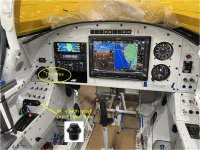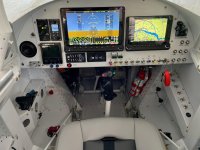claycookiemonster
Well Known Member
I've just found out that the flap switch I put on the stick grip needs another standard flap handle to operate normally. Apparently the stick grip switch isn't capable of enough current to operate the flaps?
So, now I'm looking for a non-instrument panel location for the more normal flap switch. I've seen photos of some on the aft side of the gear tower, so forward of the throttle quadrant beneath the panel. There was one aft and below the throttle quadrant in the lightening hole at an angle. I've even considered one mounted vertically on the upper surface of the throttle quadrant forward of the levers if it could be done without interfering with the cables.
Suggestions? Warnings? Lessons learned?
So, now I'm looking for a non-instrument panel location for the more normal flap switch. I've seen photos of some on the aft side of the gear tower, so forward of the throttle quadrant beneath the panel. There was one aft and below the throttle quadrant in the lightening hole at an angle. I've even considered one mounted vertically on the upper surface of the throttle quadrant forward of the levers if it could be done without interfering with the cables.
Suggestions? Warnings? Lessons learned?






